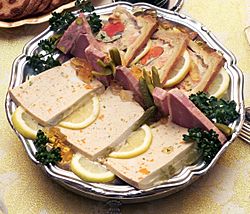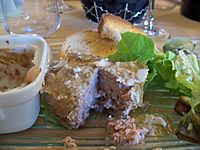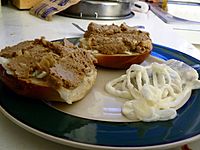Pâté facts for kids

Various pâtés
|
|
| Place of origin | France, Belgium, Vietnam and Laos |
|---|---|
| Main ingredients | Meat, fish, seafood, or vegetables |
Pâté is a tasty spread or loaf. It's made from finely ground ingredients. These can include meat like pork, chicken, fish, or beef. It also often has fat, vegetables, herbs, and spices. Sometimes, a little wine or brandy is added for flavor.
People usually enjoy pâté spread on bread or crackers. You can serve it warm or cold. Many people think it tastes best after it has been chilled for a few days. This allows the flavors to mix together perfectly.
Contents
Different Kinds of Pâté
Pâté comes in many forms around the world.
French and Belgian Pâté
In France and Belgium, pâté can be baked in a crust. This is called pâté en croûte, which means "pâté in a crust." It looks like a savory pie. Another type is pâté en terrine. This pâté is baked in a special dish called a terrine.
When making pâté en croûte, small tubes are often put on top. These "chimneys" let steam escape while it bakes. This stops the pastry crust from getting soggy. After baking, a small space can form under the crust. This space is traditionally filled with a jelly-like substance called aspic before the pâté cools down.
The most famous French pâté is probably pâté de foie gras. It is made from the livers of specially raised geese.
Pâté Around the World
- In Poland, pâté is called pasztet. It can be made from poultry, fish, or different meats like ham or pork. It often includes eggs, flour, and bread crumbs. Many other things can be added too, such as pepper, mushrooms, or even cheese.
- In Russia, pâté is usually made with beef, goose, or chicken liver. It's known as pechyonochniy pashtet, meaning "liver pâté." The liver is first cooked, then mixed with butter or fat and seasonings like onion and carrots. It can be baked, but often it's just served as is. Russian pâté is sometimes shaped like animals, such as hedgehogs, when served.
- A similar dish in Ashkenazi Jewish cuisine is called chopped liver. Instead of butter, it uses schmaltz (chicken fat). Hard-boiled eggs are also usually added. Another Jewish pâté is vorschmack, which is made from chopped herring.
- In the former Yugoslavia, a smooth pâté called pašteta is a popular spread for bread. It's usually made from liver, chicken, pork, or beef. Sometimes, it's made with tuna or salmon.
- In Vietnamese cuisine, pâté is often used in bánh mì sandwiches. This type of pâté is usually made from liver.
Liver Sausage
Sometimes, people confuse pâté with Liver sausage. In many parts of northern and central Europe, there are soft, spreadable sausages. These sausages are mostly made with liver. While similar, they are generally considered a different type of food from pâté.
See also
 In Spanish: Paté para niños
In Spanish: Paté para niños




